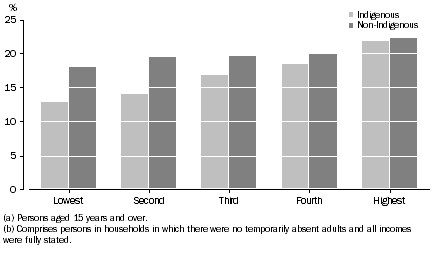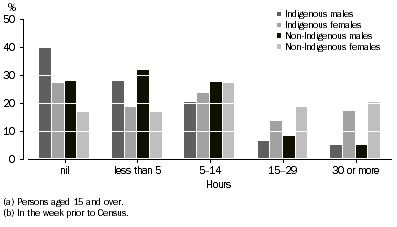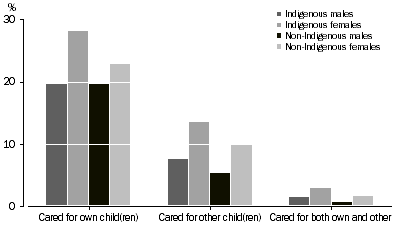UNPAID WORK
The 2006 Census saw the introduction of questions on unpaid work. These questions were applicable to people aged 15 years and over. The unpaid work questions covered four topics:
- voluntary work through/or for an organisation or group (in the 12 months prior to the Census)
- domestic work (in the week prior to the Census)
- caring for a child/children (including own child/children) (in the two weeks prior to the Census)
- caring for a person who has a disability, long-term illness or problems related to old age (in the two weeks prior to the Census).
The different time frames were chosen to best suit respondent recall, and should be taken into account when comparing unpaid work data.
For more information on these topics refer to the Glossary.
Voluntary work
Voluntary work for an organisation or group includes help willingly given by people aged 15 years and over in the form of time, services or skills to a club, organisation or association. Volunteers make an invaluable contribution to the Australian community in building and sustaining both social and welfare networks.
Over 15% of Indigenous people who responded to the voluntary work question in the Census indicated that they completed voluntary work in the previous 12 months, compared with 20% of non-Indigenous people. Indigenous females were more likely than Indigenous males to have volunteered (16% compared with 14%). For Indigenous people, those aged 45-54 years were most likely to participate in voluntary work (19%), followed by those aged 35-44 years (18%) and 55-64 years (17%). There was a similar pattern for non-Indigenous people, where the age groups most likely to participate in voluntary work were 35-44 years and 45-54 years (both 23%).
Indigenous people not in the labour force were less likely to volunteer (11%) compared with employed (18%) and unemployed Indigenous people (17%). In the non-Indigenous population, the proportion of people volunteering did not change with labour force status.
For both the Indigenous and non-Indigenous populations, the likelihood of participating in voluntary work increased with income. People in the highest income quintile, based on equivalised household income, were most likely to participate in voluntary work (22% for both the Indigenous and non-Indigenous populations).
Proportion of volunteers within equivalised household income quintiles(a)(b)

Unpaid domestic work
Unpaid domestic work includes all of the work a person does without pay in their own home and in other places, for themselves, their family and other people in their household. There has been increasing interest over the past few decades in identifying, acknowledging and valuing the unpaid work that supports home and community life.
Two-thirds of Indigenous people (67%) reported spending time doing unpaid domestic work in the week prior to the 2006 Census, compared with 78% of non-Indigenous people. Indigenous females (73%) were more likely than Indigenous males (60%) to undertake unpaid domestic work.
More than two-thirds of Indigenous males (68%) undertaking unpaid domestic work spent nil hours or less than 5 hours doing so, compared with 46% of Indigenous females. More than 40% of Indigenous females who undertook unpaid domestic work (excluding those that reporting nil hours) spent 15 or more hours over the week period, compared with 20% of males. There was a similar trend for non-Indigenous females compared with non-Indigenous males.
Hours spent completing unpaid Domestic Work(a)(b), Indigenous status by sex

Unpaid child care
Unpaid child care is the time that a person spends caring for a child or children without being paid. Over one-third (37%) of Indigenous people spent time caring for either their child and/or someone else's child in the two weeks prior to the 2006 Census, compared with 30% of non-Indigenous people. Females were more likely than males to care for children, with 45% of Indigenous females caring for children compared with 29% of males. In comparison, 34% of non-Indigenous females and 26% of non-Indigenous males cared for children.
Indigenous people were more likely to care for other children (11%) than non-Indigenous people (8%). For Indigenous people, caring for other children was most likely to occur in Very Remote (16%) and Remote (13%) areas. Indigenous people aged 55-64 years were most likely to care for other children (17%), followed by 45-54 year age group (15%). In comparison, 16% of non-Indigenous people aged 55-64 years cared for other children followed by 10% of non-Indigenous people aged 65 years or more.
Unpaid child care, Persons who cared for child/children

Unpaid assistance to a person with a disability
Unpaid assistance to a person with a disability includes help given to another person to assist with their daily activities. Of people who responded to the question, Indigenous people were more likely to provide unpaid assistance to a person with a disability than non-Indigenous people (13% compared with 11%) in the two weeks prior to the 2006 Census. Indigenous females were more likely than Indigenous males to provide unpaid assistance to a person with a disability, 16% compared with 10%. Of Indigenous people that provided unpaid assistance to a person with a disability 25% were aged 35-44 years, 22% were 25-34 years (22%) and 20% were 15-24 years.
 Print Page
Print Page
 Print All
Print All